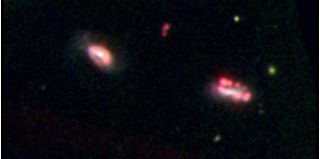Elusive Dwarf Galaxies Found Hidden Away in Tiny Clusters

Computer simulations and theoretical models have shown that clusters of miniature galaxies, some 10- to 1,000 times smaller than the Milky Way, should exist, but proof has been elusive. Detections of dwarf galaxy clusters would provide key evidence that the current theory for how the universe evolved structures is correct.
The so-called Lambda Cold Dark Matter paradigm is the prediction that smaller things merge to form bigger things, University of Virginia astronomer Sabrina Stierwalt told Seeker. But there has been scant observational evidence of this process for low-mass galaxies despite the fact that small galaxies greatly outnumber bigger ones like the Milky Way, she added.
In paper published in this week's Nature Astronomy, Stierwalt and colleagues describe a new hunt for dwarf galaxy clusters using data from the Sloan Digital Sky Survey.
The team first looked for pairs of interacting dwarf galaxies, then studied those pairs to see if they could be part of a bigger group.
Follow-up observations with the Magellan Telescope in Chile, the Apache Point Observatory in New Mexico and the Gemini North Telescope in Hawaii provided optical images and spectroscopy of additional suspected group members.
RELATED: Dark Matter Dwarf Galaxy Found Hidden in Spacetime Warp
In all, the scientists found seven groups of dwarf galaxies, each with three- to five members.
Get the Space.com Newsletter
Breaking space news, the latest updates on rocket launches, skywatching events and more!
"We suspect these groups are gravitationally bound and thus will eventually merge to form one larger, intermediate-mass galaxy," Stierwalt said.
The galaxies are located between 200 million and 650 million light-years from Earth.
"That sounds like a lot but it is relatively nearby given the vast size of the universe. Dwarf galaxies are fainter and smaller than more massive galaxies like the Milky Way we reside in, and so they are harder to detect at farther distances," Stierwalt said.
The number of clusters matches predictions, which builds confidence in the computer models.
"Such groups are predicted to be rare theoretically and found to be rare observationally at the current epoch," the astronomers noted in the paper.
RELATED: Could Nearby Dwarf Galaxy be a Dark Matter Factory?
The newly found dwarf galaxy groups "provide direct probes of hierarchical structure formation in action at the low mass end, giving us a new window into a process expected to be common at earlier times, but nearly impossible to observe at such redshifts," the paper said.
"Redshifts" is a cosmic yardstick for measuring distance and time. It refers to the lengthening of wavelengths of light as a radiating object moves farther away, similar to how the sound of a train shifts as it recedes.
WATCH VIDEO: This Is How We See The Universe
Originally published on Seeker.
Join our Space Forums to keep talking space on the latest missions, night sky and more! And if you have a news tip, correction or comment, let us know at: community@space.com.

Irene Klotz is a founding member and long-time contributor to Space.com. She concurrently spent 25 years as a wire service reporter and freelance writer, specializing in space exploration, planetary science, astronomy and the search for life beyond Earth. A graduate of Northwestern University, Irene currently serves as Space Editor for Aviation Week & Space Technology.
